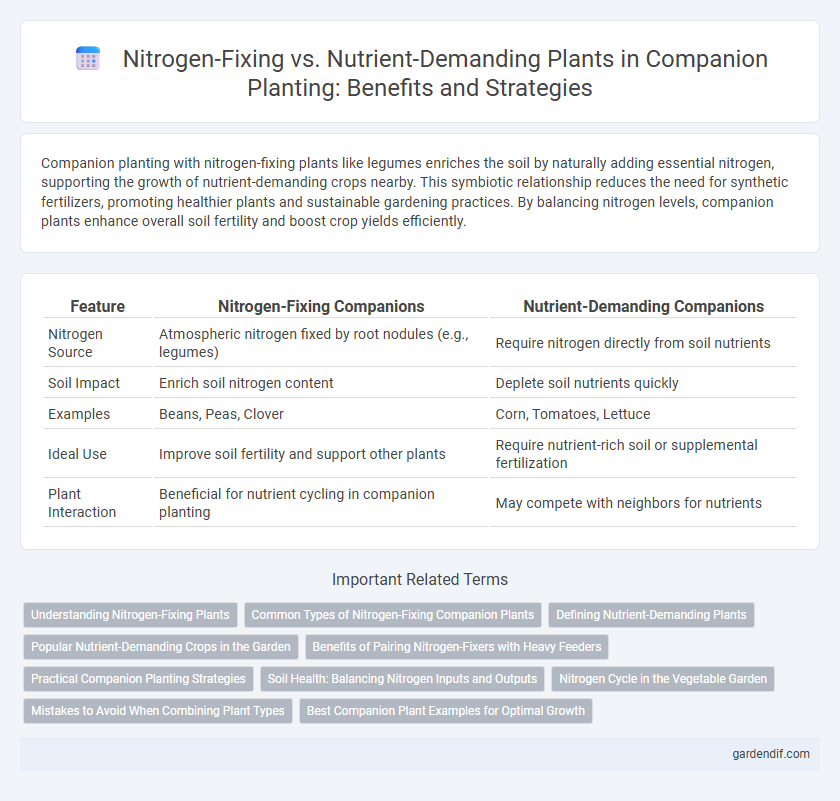
Nitrogen-fixing vs nutrient-demanding Illustration
Companion planting with nitrogen-fixing plants like legumes enriches the soil by naturally adding essential nitrogen, supporting the growth of nutrient-demanding crops nearby. This symbiotic relationship reduces the need for synthetic fertilizers, promoting healthier plants and sustainable gardening practices. By balancing nitrogen levels, companion plants enhance overall soil fertility and boost crop yields efficiently.
Table of Comparison
| Feature | Nitrogen-Fixing Companions | Nutrient-Demanding Companions |
|---|---|---|
| Nitrogen Source | Atmospheric nitrogen fixed by root nodules (e.g., legumes) | Require nitrogen directly from soil nutrients |
| Soil Impact | Enrich soil nitrogen content | Deplete soil nutrients quickly |
| Examples | Beans, Peas, Clover | Corn, Tomatoes, Lettuce |
| Ideal Use | Improve soil fertility and support other plants | Require nutrient-rich soil or supplemental fertilization |
| Plant Interaction | Beneficial for nutrient cycling in companion planting | May compete with neighbors for nutrients |
Understanding Nitrogen-Fixing Plants
Nitrogen-fixing plants, such as legumes, convert atmospheric nitrogen into a usable form through symbiotic relationships with root bacteria, enhancing soil fertility naturally. These plants reduce the need for synthetic nitrogen fertilizers, promoting sustainable agriculture by improving nutrient cycling and supporting companion crops. Understanding their nitrogen-fixing capabilities allows farmers to strategically pair them with nutrient-demanding plants, optimizing growth and crop yield.
Common Types of Nitrogen-Fixing Companion Plants
Common types of nitrogen-fixing companion plants include legumes such as clover, peas, beans, and vetch, which have symbiotic relationships with Rhizobium bacteria to convert atmospheric nitrogen into usable forms for surrounding plants. These companion plants enhance soil fertility by enriching nitrogen levels, reducing the need for synthetic fertilizers in nutrient-demanding crops like corn, tomatoes, and leafy greens. Integrating nitrogen-fixing companions into crop rotations or intercropping systems promotes sustainable agriculture and improves overall plant health and yield.
Defining Nutrient-Demanding Plants
Nutrient-demanding plants require high levels of essential elements such as nitrogen, phosphorus, and potassium to achieve optimal growth and productivity. Unlike nitrogen-fixing plants, which convert atmospheric nitrogen into usable forms through symbiotic bacteria like Rhizobium, nutrient-demanding plants rely heavily on soil nutrient availability and often necessitate supplemental fertilization. Understanding the nutrient uptake mechanisms and soil nutrient requirements of these plants is critical for effective companion planting strategies and sustainable agricultural practices.
Popular Nutrient-Demanding Crops in the Garden
Popular nutrient-demanding crops in the garden include tomatoes, corn, and lettuce, which require high levels of nitrogen, phosphorus, and potassium for optimal growth. These crops benefit from companion planting with nitrogen-fixing plants like beans and clover that naturally enrich soil fertility. Understanding the nutrient demands of specific crops helps gardeners maximize yield while maintaining soil health through strategic companion planting.
Benefits of Pairing Nitrogen-Fixers with Heavy Feeders
Pairing nitrogen-fixing plants such as legumes with nutrient-demanding heavy feeders like corn or tomatoes enhances soil fertility by naturally increasing available nitrogen, reducing the need for synthetic fertilizers. This symbiotic relationship improves crop yields and promotes sustainable agricultural practices by maintaining soil health and nutrient balance. The nitrogen fixers convert atmospheric nitrogen into forms accessible to heavy feeders, supporting robust plant growth and long-term productivity.
Practical Companion Planting Strategies
Nitrogen-fixing companion plants, such as clover and legumes, enrich soil fertility by converting atmospheric nitrogen into forms accessible to nutrient-demanding crops like tomatoes and corn. Strategically interplanting these species enhances nutrient availability, reduces synthetic fertilizer dependency, and supports sustainable crop growth. Selecting compatible pairs based on nitrogen needs optimizes soil health and maximizes yield in companion planting systems.
Soil Health: Balancing Nitrogen Inputs and Outputs
Nitrogen-fixing companion plants such as legumes enhance soil health by converting atmospheric nitrogen into bioavailable forms, reducing the need for synthetic fertilizers. Nutrient-demanding crops extract significant nitrogen from the soil, necessitating effective management to prevent nutrient depletion. Balancing nitrogen inputs from nitrogen-fixing plants with the outputs of nutrient-demanding companions promotes sustainable soil fertility and long-term ecosystem productivity.
Nitrogen Cycle in the Vegetable Garden
Nitrogen-fixing companion plants, such as legumes, play a crucial role in the nitrogen cycle by converting atmospheric nitrogen into forms accessible to nutrient-demanding vegetables, enhancing soil fertility naturally. Incorporating these plants in a vegetable garden reduces the need for synthetic nitrogen fertilizers and supports sustainable growth. This symbiotic relationship promotes balanced nutrient availability, improving overall plant health and yield.
Mistakes to Avoid When Combining Plant Types
Combining nitrogen-fixing plants with nutrient-demanding companions requires careful planning to prevent competition and nutrient imbalances. Avoid planting heavy feeders too close to nitrogen fixers, as they may outcompete or inhibit the latter's ability to enrich the soil. Proper spacing and understanding each species' nutrient requirements ensure a balanced ecosystem that maximizes growth and soil health.
Best Companion Plant Examples for Optimal Growth
Leguminous plants such as clover and peas serve as excellent nitrogen-fixing companions, enriching soil fertility by converting atmospheric nitrogen into a usable form. Nutrient-demanding plants like tomatoes and corn benefit significantly from these companions, as the improved nitrogen availability supports their optimal growth and yields. Intercropping nitrogen-fixing companions with high-demand crops enhances soil health and maximizes nutrient uptake, promoting sustainable agricultural productivity.
Nitrogen-fixing vs nutrient-demanding Infographic

 gardendif.com
gardendif.com